Lincoln Bank Building
1921, 1983, 2013
PDF of the Lincoln Bank Building History
The Lincoln Bank was established by Harry Pence in 1917. Pence, an automobile magnate, had built his namesake Pence Building at 800 Hennepin Avenue in 1909. He created the Lincoln Bank in 1917, with $250,000 in capital to serve the area automobile and Hennepin Avenue businesses. By 1919, sales of automobiles, trucks, tractors, and related supplies in Minneapolis had reached $354 million. At the time, the banking industry was on Marquette with retail on Nicollet and entertainment on Hennepin. Lincoln Bank saw this diversity of location as an asset. In addition, the automobile business was on Hennepin.
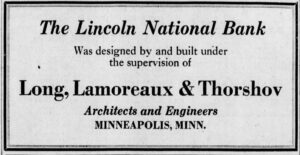
The Bank did well, and Pence decided to build larger quarters on the corner of Eight and Hennepin. The building was designed by Long, Lamoreaux, and Thorshov, the same architects who had designed the earlier Pence Building. The Lincoln was completed at a cost of one million dollars. The contractor was J.L. Robinson Company.
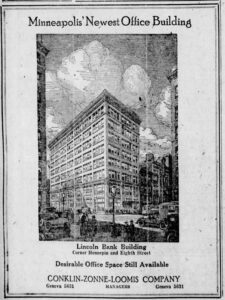
When it opened, Lincoln Bank was advertised in the Star Tribune of August 9, 1921, to be “Minneapolis’ newest and most modern building. Its location is unsurpassed, as one is always quickly and easily in touch with the business of the city.”
The construction was reinforced concrete with terra cotta and an enameled brick exterior.
The eight-floor building was to house more than the Bank. The Lincoln National Bank, the Lincoln Trust Company, and the Lincoln Savings Bank were to occupy the first two floors. The second floor was to be occupied by the Lincoln National Life Insurance Company which was moving from Fargo to Minneapolis.
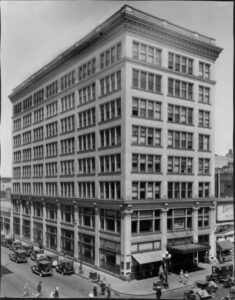
The Federal Board of Vocational Training would occupy 2,000 square feet on the third floor. The upper floors would be rented as office space. The lower level of the building contained the bank vault which was a highlight of the original building.
The Lincoln Bank Building’s main floors had marble wainscotting, mahogany woodwork, and polished wire plate glass. The doors were bronze. A marble stair led to the vault in the basement. The vault doors are visible from the first floor (following a remodel in 1982).
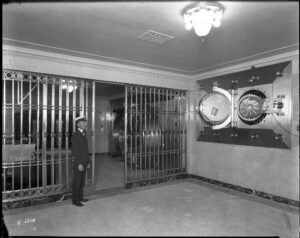
The upper stories had terrazzo floors, plaster walls, and plastered concrete ceilings.
The exterior of the building is similar in overall appearance and complements its neighbor, the Pence Building. The exteriors of both buildings were of the same shade of terra cotta.
The two street-facing facades of the building are dominated by large window bays. Tile pilasters with inset panels topped with ornamental brackets support a cornice that runs along the top of the second story. Above the cornices are terra cotta shields with abstract stars and stripes. Glazed white brick faces the third through the eighth floors. A decorative cornice with corbels and dentils sits below the roofline. The two sides that do not face the street are common brick painted a cream color.
The Bank was named for Abraham Lincoln whose attributes were desirable for the Bank.
The same year that the building opened, 1921, the Lincoln Bank was acquired by Northwestern National Bank (now Wells Fargo). Pence became a Northwestern National board member. In 1929, Northwestern restructured with a new holding company. That same year, the stock market crashed, plunging the banking industry into major changes.
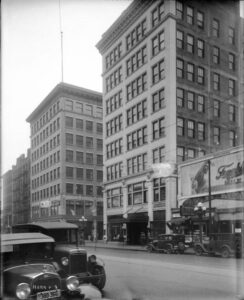
Pence died in March of 1933. He had been one of the world’s most influential automobile dealers. Financing the purchase of automobiles grew popular in the early 1900s. He opened one of the city’s first car dealerships in 1903. When the Lincoln Bank Building opened in 1921, more than one hundred auto-related businesses operated in the neighborhood. The Lincoln Bank also provided its services to large corporations and businesses in the neighborhood.
Pence’s activities were not limited to automobiles. His first employment in Minneapolis was at his uncle’s establishment, Pence Opera House. From there, he worked on riverboats, established automobile dealerships, acquired railroads, and created a bank.
The Bank encouraged the use of its spaces, including the community room. The room featured meetings of various groups.
Northwestern National Bank’s maintained its presence in the Lincoln Bank Building for three decades. It was the largest of the Northwestern National Bank branches. When Northwestern did move in 1952, it moved into the Pence Building which had been converted into offices in the 1930s.
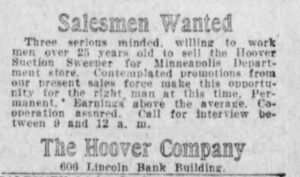
Tenants during the 1920s included D.C. Bennett, Inc., Architects; The Hoover Company (Suction Sweepers then, vacuums now); Western Union; M.N.& S. Railway; G.L. Miller & Company.
In 1930, the Lincoln Bank Building’s name was changed to the Pence Building; and the Pence Building’s name was changed to the Gas Light Building. Name changes to the building continued in subsequent years.
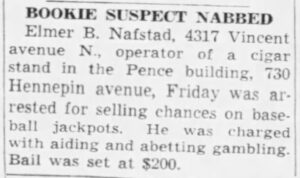
A variety of tenants occupied the building in the 1940s. An article in the Star Tribune on June 12, 1948, reported that a cigar stand operator in the building was arrested for aiding and abetting gambling.
Tenants in the 1950s included The Boston and Old Colony Insurance Companies, Palm’s Dance Studio, AFL-CIO Regional Office, and Roosevelt Finance Company.
Roosevelt had its offices on the second floor. The Minneapolis Star Tribune in an article on August 6, 1957, reported that Roosevelt Finance was robbed. A sign in the offices read “Need Money? Ask the Cashier.”

In 1960, tenants of the building included Twin-City Real-Estate School, Academy of Accountancy, Home Federal Savings, and AAACon Auto Transport.
Tenants in the 1970s included the Church of Scientology.
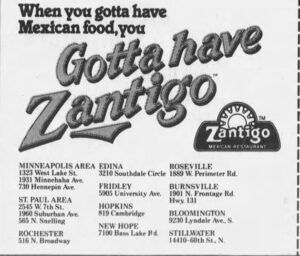
In 1979, the building was purchased by Kerr Investments but sold 18 months later to Kensington Properties. Kerr had renamed the building Omni.
On October 30, 1982, a Minneapolis Star Tribune article noted that the 63-year-old building was to be renovated with work beginning with a redesigned lobby, new restrooms and elevators, and updated mechanical systems.
In 1983, Kensington Properties renamed the building City Place, and restoration was planned. Korsunsky Krank Erickson Inc. was selected as the architect. Plans included a glass-walled elevator with glass-lined corridors on all eight floors.
As restoration plans were to be done floor by floor, two thirty-five-year tenants were staying on—Diversified Discount & Acceptance and Freimy Heligman, Watch Repair. Zantigo’s Restaurant occupied the first floor from 1980 until 1986.
National City Business Credit and Tailor Express were also tenants in the 1980s.
The Minnesota Timberwolves had an office in the building in the 1990s as did the National Association of Credit Management. Metropolitan State University was also located in the building in the 1990s and into the 2000s.
In 2007, the Lincoln International Charter School occupied the first-floor space in the building. For a time, the International Education Center, under the auspices of the Institute for New Americans, also operated on the main floor of the building.
The Lincoln Bank Building was listed on the National Register of Historic Places in 2012.
In 2013, the Lincoln Bank Building’s top seven floors were approved for residential development. The top floors, City Place Lofts, are affordable housing operated by Trellis.
